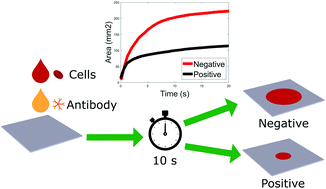A rapid paper-based blood typing method from droplet wicking†
Abstract
Paper-based diagnostics are leading the field of low-cost, point of care analytical techniques. However, large scale testing facilities such as hospitals are still primarily using the gel column agglutination technique. This is because paper-based systems are single use tests that are generally more time consuming and less automatable than traditional methods. Here, we present a novel, rapid and scalable, paper-based blood typing method that can produce test results in under ten seconds. We believe this is the fastest blood typing test that is appropriate for large scale automation. The test consists of placing a drop of antibody solution on paper, followed by a drop of blood on the same locus, and measuring the evolution of blood stain area as a function of time. Positive reactions for both forward and reverse tests have significantly slower growth rates and smaller final stain sizes when compared to negatives. We analyse the effect paper type, red blood cell concentration, antibody specificity (A, B and D) and antibody dilution have on the sensitivity and reproducibility of the technique. A high sensitivity is found in papers with a low density and thickness. The optimum red blood cell concentration is determined from a balance between wicking rate, strength of reaction and optical contrast. A and B antibodies give more sensitive results than D; however, the D antigen can still be successfully identified. This technique has the potential to significantly cut down the time and cost of blood typing tests and enable design of a new high throughput and fully automatable system.



 Please wait while we load your content...
Please wait while we load your content...